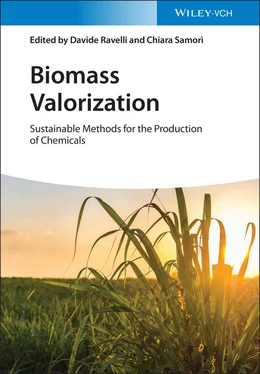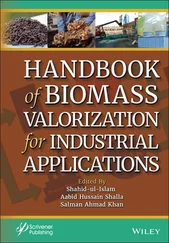Biomass Valorization
Здесь есть возможность читать онлайн «Biomass Valorization» — ознакомительный отрывок электронной книги совершенно бесплатно, а после прочтения отрывка купить полную версию. В некоторых случаях можно слушать аудио, скачать через торрент в формате fb2 и присутствует краткое содержание. Жанр: unrecognised, на английском языке. Описание произведения, (предисловие) а так же отзывы посетителей доступны на портале библиотеки ЛибКат.
- Название:Biomass Valorization
- Автор:
- Жанр:
- Год:неизвестен
- ISBN:нет данных
- Рейтинг книги:3 / 5. Голосов: 1
-
Избранное:Добавить в избранное
- Отзывы:
-
Ваша оценка:
- 60
- 1
- 2
- 3
- 4
- 5
Biomass Valorization: краткое содержание, описание и аннотация
Предлагаем к чтению аннотацию, описание, краткое содержание или предисловие (зависит от того, что написал сам автор книги «Biomass Valorization»). Если вы не нашли необходимую информацию о книге — напишите в комментариях, мы постараемся отыскать её.
Explore the potential of biomass-based chemicals with this comprehensive new reference from leading voices in the field Biomass Valorization: Sustainable Methods for the Production of Chemicals
Biomass Valorization: Sustainable Methods for the Production of Chemicals
Biomass Valorization — читать онлайн ознакомительный отрывок
Ниже представлен текст книги, разбитый по страницам. Система сохранения места последней прочитанной страницы, позволяет с удобством читать онлайн бесплатно книгу «Biomass Valorization», без необходимости каждый раз заново искать на чём Вы остановились. Поставьте закладку, и сможете в любой момент перейти на страницу, на которой закончили чтение.
Интервал:
Закладка:
37 37. Xu, C., Nasrollahzadeh, M., Selva, M. et al. (2019). Waste‐to‐wealth: biowaste valorization into valuable bio(nano)materials. Chemical Society Reviews 48: 4791–4822. https://doi.org/10.1039/C8CS00543E.
38 38. Lin, C.S.K. (2018). Chemistry and Chemical Technologies in Waste Valorization. Cham: Springer.
39 39. Seyboth, K., Matschoss, P., Kadner, S. et al. (2012). Intergovernmental panel on climate change. In: Renewable Energy Souces and Climate Change Mitigation (eds. O. Edenhofer, R.P. Madruga and Y. Sokona), 161–208. New York: Cambridge University Press.
40 40. Wang, M., Dewil, R., Maniatis, K. et al. (2019). Biomass‐derived aviation fuels: challenges and perspective. Progress in Energy and Combustion Science 74: 31–49.
41 41. Vassilev, S.V., Baxter, D., Andersen, L.K. et al. (2012). An overview of the organic and inorganic phase composition of biomass. Fuel 94: 1–33. https://doi.org/10.1016/j.fuel.2011.09.030.
42 42. Zabed, H., Sahu, J., Suely, A. et al. (2017). Bioethanol production from renewable sources: current perspectives and technological progress. Renewable and Sustainable Energy Reviews 71: 475–501. https://doi.org/10.1016/j.rser.2016.12.076.
43 43. Bruyn, M.D., Fan, J., Budarin, V.L. et al. (2016). A new perspective in bio‐refining: levoglucosenone and cleaner lignin from waste biorefinery hydrolysis lignin by selective conversion of residual saccharides. Energy & Environmental Science 9 (8): 2571–2574. https://doi.org/10.1039/c6ee01352j.
44 44. Werpy, T.A., Holladay, J.E., and White, J.F. (2004). Top Value Added Chemicals From Biomass: I. Results of Screening for Potential Candidates from Sugars and Synthesis Gas. Oak Ridge (TN): Pacific Northwest National Laboratory (PNNL) and the National Renewable Energy Laboratory (NREL).
45 45. Bozell, J.J. and Petersen, G.R. (2010). Technology development for the production of biobased products from biorefinery carbohydrates – the US Department of Energy's “Top 10” revisited. Green Chemistry 12 (4): 539. https://doi.org/10.1039/b922014c.
46 46. Gallezot, P. (2012). Conversion of biomass to selected chemical products. Chemical Society Reviews 41 (4): 1538–1558. https://doi.org/10.1039/c1cs15147a.
47 47. Isikgor, F.H. and Becer, C.R. (2015). Lignocellulosic biomass: a sustainable platform for the production of bio‐based chemicals and polymers. Polymer Chemistry 6 (25): 4497–4559. https://doi.org/10.1039/c5py00263j.
48 48. Spierling, S., Knüpffer, E., Behnsen, H. et al. (2018). Bio‐based plastics – a review of environmental, social and economic impact assessments. Journal of Cleaner Production 185: 476–491. https://doi.org/10.1016/j.jclepro.2018.03.014.
49 49. YXY Technology. (2019). https://www.avantium.com/renewable-polymers/yxy-technology/(accessed 10 September 2019).
50 50. Liu, B. and Zhang, Z. (2016). One‐pot conversion of carbohydrates into furan derivatives via furfural and 5‐hydroxylmethylfurfural as intermediates. ChemSusChem 9 (16): 2015–2036. https://doi.org/10.1002/cssc.201600507.
51 51. Van Zandvoort, I., Wang, Y., Rasrendra, C.B. et al. (2013). Formation, molecular structure, and morphology of humins in biomass conversion: influence of feedstock and processing conditions. ChemSusChem 6 (9): 1745–1758. https://doi.org/10.1002/cssc.201300332.
52 52. Rice, F.A.H. (1958). Effect of aqueous sulfuric acid on reducing sugars. V. Infrared studies on the humins formed by the action of aqueous sulfuric acid on the aldopentoses and on the aldehydes derived from them. Journal of Organic Chemistry 23 (3): 465–468. https://doi.org/10.1021/jo01097a036.
53 53. Hoang, T.M.C., van Eck, E.R.H., Bula, W.P. et al. (2015). Humin based by‐products from biomass processing as a potential carbonaceous source for synthesis gas production. Green Chemistry 17 (2): 959–972. https://doi.org/10.1039/c4gc01324g.
54 54. Girisuta, B. (2007). Levulinic acid from lignocellulosic biomass. PhD thesis. University of Groningen.
55 55. Tang, P. and Yu, J. (2014). Kinetic analysis on deactivation of a solid Brønsted acid catalyst in conversion of sucrose to levulinic acid. Industrial & Engineering Chemistry Research 53 (29): 11629–11637. https://doi.org/10.1021/ie501044c.
56 56. Ferreira‐Leitão, V., Cammarota, M., Aguieiras, E.G. et al. (2017). The protagonism of biocatalysis in green chemistry and its environmental benefits. Catalysts 7 (12): 9. https://doi.org/10.3390/catal7010009.
57 57. Scott, E. L., Bruins, M. E., and Sanders, J. P. M. (2013). Rules for the biobased production of bulk chemicals on a small scale. Wageningen UR Report BCH 2013/016.
58 58. Asghari, F.S. and Yoshida, H. (2006). Acid‐catalyzed production of 5‐hydroxymethyl furfural from d‐fructose in subcritical water. Industrial & Engineering Chemistry Research 45 (7): 2163–2173. https://doi.org/10.1021/ie051088y.
59 59. Roman‐Leshkov, Y. (2006). Phase modifiers promote efficient production of hydroxymethylfurfural from fructose. Science 312 (5782): 1933–1937. https://doi.org/10.1126/science.1126337.
60 60. Watanabe, M., Aizawa, Y., Iida, T. et al. (2005). Glucose reactions with acid and base catalysts in hot compressed water at 473 K. Carbohydrate Research 340 (12): 1925–1930. https://doi.org/10.1016/j.carres.2005.06.017.
61 61. Choudhary, V., Mushrif, S.H., Ho, C. et al. (2013). Insights into the interplay of Lewis and Brønsted acid catalysts in glucose and fructose conversion to 5‐(hydroxymethyl)furfural and levulinic acid in aqueous media. Journal of the American Chemical Society 135 (10): 3997–4006. https://doi.org/10.1021/ja3122763.
62 62. Filiciotto, L. (2019). Structural insights and valorization of humins: a catalytic approach. PhD thesis. Universidad de Córdoba.
63 63. Morales, G., Melero, J.A., Paniagua, M. et al. (2014). Sulfonic acid heterogeneous catalysts for dehydration of C6‐monosaccharides to 5‐hydroxymethylfurfural in dimethyl sulfoxide. Chinese Journal of Catalysis 35 (5): 644–655. https://doi.org/10.1016/s1872-2067(14)60020-6.
64 64. Dias, A.S., Pillinger, M., and Valente, A.A. (2005). Liquid phase dehydration of D‐xylose in the presence of Keggin‐type heteropolyacids. Applied Catalysis A: General 285 (1–2): 126–131. https://doi.org/10.1016/j.apcata.2005.02.016.
65 65. Soh, L. and Eckelman, M.J. (2016). Green solvents in biomass processing. ACS Sustainable Chemistry & Engineering 4 (11): 5821–5837. https://doi.org/10.1021/acssuschemeng.6b01635.
66 66. Yara‐Varón, E., Selka, A., Fabiano‐Tixier, A.S. et al. (2016). Solvent from forestry biomass. Pinane a stable terpene derived from pine tree byproducts to substitute n‐hexane for the extraction of bioactive compounds. Green Chemistry 18 (24): 6596–6608. https://doi.org/10.1039/c6gc02191c.
67 67. Diallo, A.O., Len, C., Morgan, A.B. et al. (2012). Revisiting physico–chemical hazards of ionic liquids. Separation and Purification Technology 97: 228–234. https://doi.org/10.1016/j.seppur.2012.02.016.
68 68. Menegazzo, F., Ghedini, E., and Signoretto, M. (2018). 5‐Hydroxymethylfurfural (HMF) production from real biomasses. Molecules 23 (9): 2201. https://doi.org/10.3390/molecules23092201.
69 69. Cicci, A., Sed, G., Jessop, P.G. et al. (2018). Circular extraction: an innovative use of switchable solvents for the biomass biorefinery. Green Chemistry 20 (17): 3908–3911. https://doi.org/10.1039/c8gc01731j.
70 70. Fu, D., Farag, S., Chaouki, J. et al. (2014). Extraction of phenols from lignin microwave‐pyrolysis oil using a switchable hydrophilicity solvent. Bioresource Technology 154: 101–108. https://doi.org/10.1016/j.biortech.2013.11.091.
71 71. Wang, C., Zhang, L., Zhou, T. et al. (2017). Synergy of Lewis and Brønsted acids on catalytic hydrothermal decomposition of carbohydrates and corncob acid hydrolysis residues to 5‐hydroxymethylfurfural. Scientific Reports 7 (1): 1,, Article ID 40908–9. https://doi.org/10.1038/srep40908.
Читать дальшеИнтервал:
Закладка:
Похожие книги на «Biomass Valorization»
Представляем Вашему вниманию похожие книги на «Biomass Valorization» списком для выбора. Мы отобрали схожую по названию и смыслу литературу в надежде предоставить читателям больше вариантов отыскать новые, интересные, ещё непрочитанные произведения.
Обсуждение, отзывы о книге «Biomass Valorization» и просто собственные мнения читателей. Оставьте ваши комментарии, напишите, что Вы думаете о произведении, его смысле или главных героях. Укажите что конкретно понравилось, а что нет, и почему Вы так считаете.












